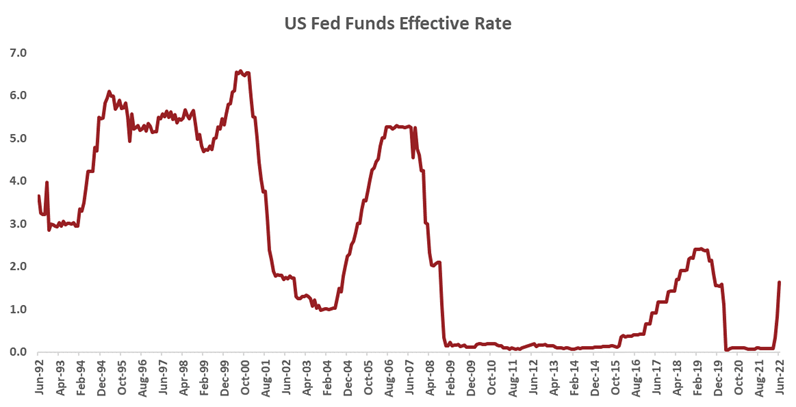sinseeho/iStock via Getty Images
For the first time since 1994, the U.S. Federal Reserve (FED) raised the federal funds rate by 0.75 percentage points to an effective range of 1.50% to 1.75%—conveying its seriousness about tackling inflation and inflation expectations. The Fed’s move wasn’t entirely surprising, after markets were tipped off by a Wall Street Journal story late Monday indicating that a 75 basis-point (bps) hike was likely. This may explain today’s equity rally, which gained strength after the start of Chairman Jerome Powell’s press conference.
So, what changed in the latest Fed outlook, when compared to projections made earlier in the year? Let’s unpack it all, starting with inflation.
Fed Increases Inflation Projections, Sees Cash Rate Of 3.375% At Year-End
The Fed revised its 2022 headline and core PCE (personal consumption expenditures) inflation expectations to 5.2% from 4.3%, and to 4.3% from 4.1%, as compared to March, and expects inflation to stay above its 2% target over the projection horizon (through 2023). Ultimately, stronger inflation and rising consumer expectations for inflation have forced the Fed’s hand.
 Source: Refinitiv DataStream, Russell Investments.
Source: Refinitiv DataStream, Russell Investments.
At the press conference, Chairman Powell commented that by the end of 2022, the central bank intends to raise its policy rate to a modestly restrictive level, which it believes is between 3.0% and 3.5%— effectively what the dot plots revealed. The Fed expects the federal funds rate to reach 3.375% in 2022 and 3.75% in 2023, implying an additional 175-bps tightening in the remaining four meetings this year. This means that further super-sized rate hikes are forthcoming. Indeed, Powell commented that 75-bps hikes are atypically large, but hinted toward either a 50-bps or 75-bps move at the July meeting.
Economic Growth Projections Revised Downward
As policy rates shift from accommodative to restrictive, the Fed expects softer economic growth and higher unemployment relative to its March projections. Gross domestic product (GDP) growth in 2022 and 2023 was downgraded to 1.7%, below prior forecasts of 2.8% and 2.2%, respectively, and the unemployment rate is expected to rise by 0.2% and 0.4% in 2022 and 2023, to 3.7% and 3.9%.
Crucially, the Fed’s updated economic projections suggest a soft(ish) landing of the economy. While growth is expected to slow and the unemployment rate is predicted to edge slightly higher, there is no recession through its projection horizon. This conflicts with how market pricing is evolving and what leading indicators predict.
For instance, a widely followed segment of the yield curve—the spread between the 10-year and 2-year U.S. Treasury yield—briefly inverted this week. It had also done so momentarily in April. Historically, the yield curve has been a prescient recession predictor. Moreover, swap markets are pricing that the target rate will peak near 4% around May 2023, and penciling in a declining rate path after that. This is above the level at which the Fed expects its policy rate to peak, and roughly 150 bps above the central bank’s estimated neutral rate. In other words, markets have priced a more aggressive rate path than the Fed for the next 12 months and a downward sloping Fed rate beyond then. Therefore, while current economic conditions are healthy and underpinned by a tight labor market, financial conditions are tightening, and recession concerns are growing for the second half of 2023.
2023 Recession Risks Are Rising. How Much Of This Is Already Priced In By Markets?
While talk of a recession is alarming, it’s a necessary evil to reset the system, so to speak, by bringing inflation and an overheating economy back under control. And the glass-half-full view is that if the U.S. economy is headed toward a recession, then a good portion of that outlook may already be priced in.
Consider, for instance, that the average recession drawdown is about 35%, and that the S&P 500 Index is already in bear-market territory, having fallen over 20% since its Jan. 3 high. In other words, the current pullback in equities is advanced. That said, equity bear markets never feel comfortable, and volatility will likely persist until the Fed is convinced that inflation is sustainably trending down and, therefore, its policy stance can pivot.
For today’s investors, it’s worth looking back a year or two, to the pandemic drawdown and subsequent rally, for a reminder of the dangers of trying to time market entry and exit points. Going forward, we believe maintaining investment discipline—by staying invested and sticking to your plan—will be of crucial importance.
Disclosures
These views are subject to change at any time based upon market or other conditions and are current as of the date at the top of the page. The information, analysis, and opinions expressed herein are for general information only and are not intended to provide specific advice or recommendations for any individual or entity.
This material is not an offer, solicitation or recommendation to purchase any security.
Forecasting represents predictions of market prices and/or volume patterns utilizing varying analytical data. It is not representative of a projection of the stock market, or of any specific investment.
Nothing contained in this material is intended to constitute legal, tax, securities or investment advice, nor an opinion regarding the appropriateness of any investment. The general information contained in this publication should not be acted upon without obtaining specific legal, tax and investment advice from a licensed professional.
Please remember that all investments carry some level of risk, including the potential loss of principal invested. They do not typically grow at an even rate of return and may experience negative growth. As with any type of portfolio structuring, attempting to reduce risk and increase return could, at certain times, unintentionally reduce returns.
The information, analysis and opinions expressed herein are for general information only and are not intended to provide specific advice or recommendations for any individual entity.
Frank Russell Company is the owner of the Russell trademarks contained in this material and all trademark rights related to the Russell trademarks, which the members of the Russell Investments group of companies are permitted to use under license from Frank Russell Company. The members of the Russell Investments group of companies are not affiliated in any manner with Frank Russell Company or any entity operating under the “FTSE RUSSELL” brand.
The Russell logo is a trademark and service mark of Russell Investments.
This material is proprietary and may not be reproduced, transferred, or distributed in any form without prior written permission from Russell Investments. It is delivered on an “as is” basis without warranty.
The S&P 500® Index, or the Standard & Poor’s 500, is a stock market index based on the market capitalizations of 500 large companies having common stock listed on the NYSE or NASDAQ.
UNI-12064
Editor’s Note: The summary bullets for this article were chosen by Seeking Alpha editors.


Be the first to comment